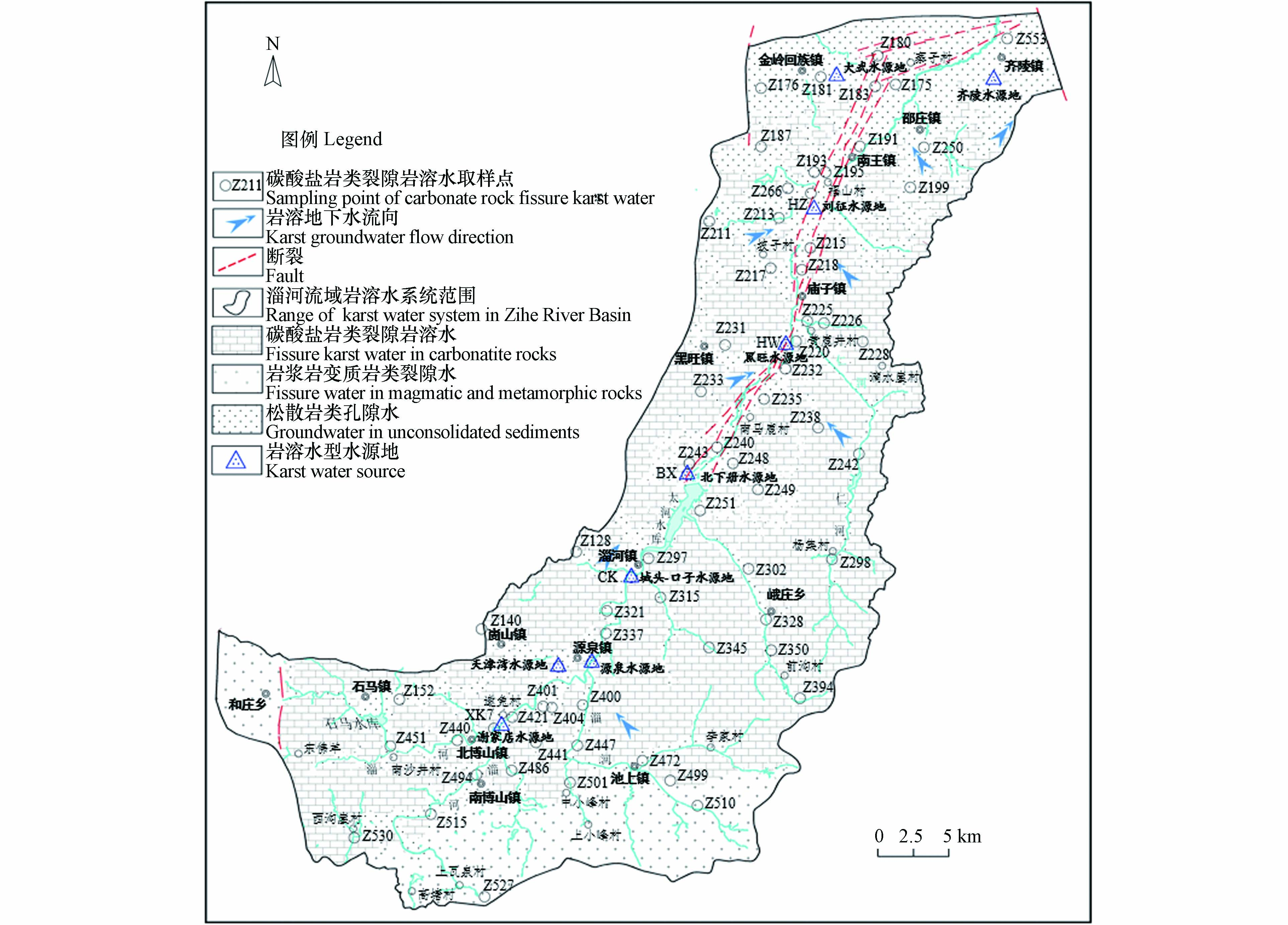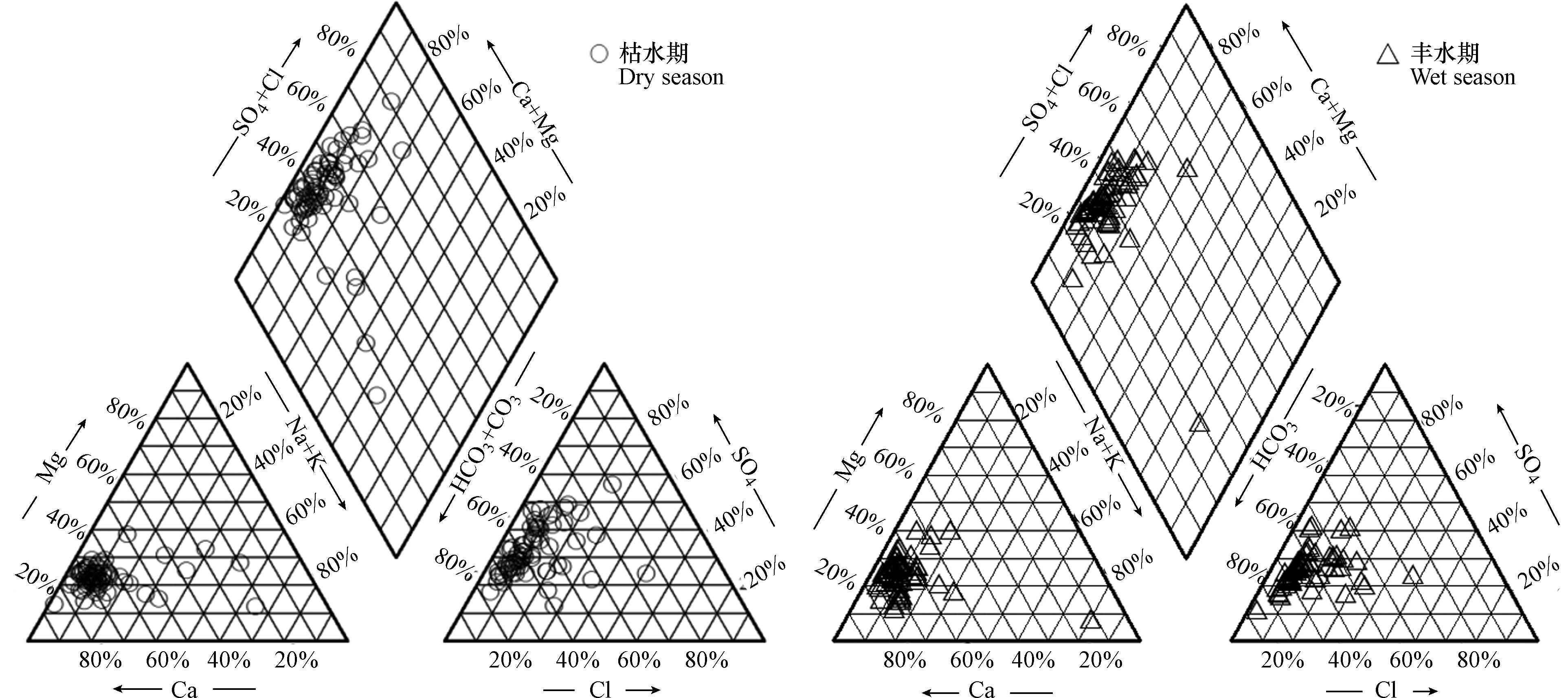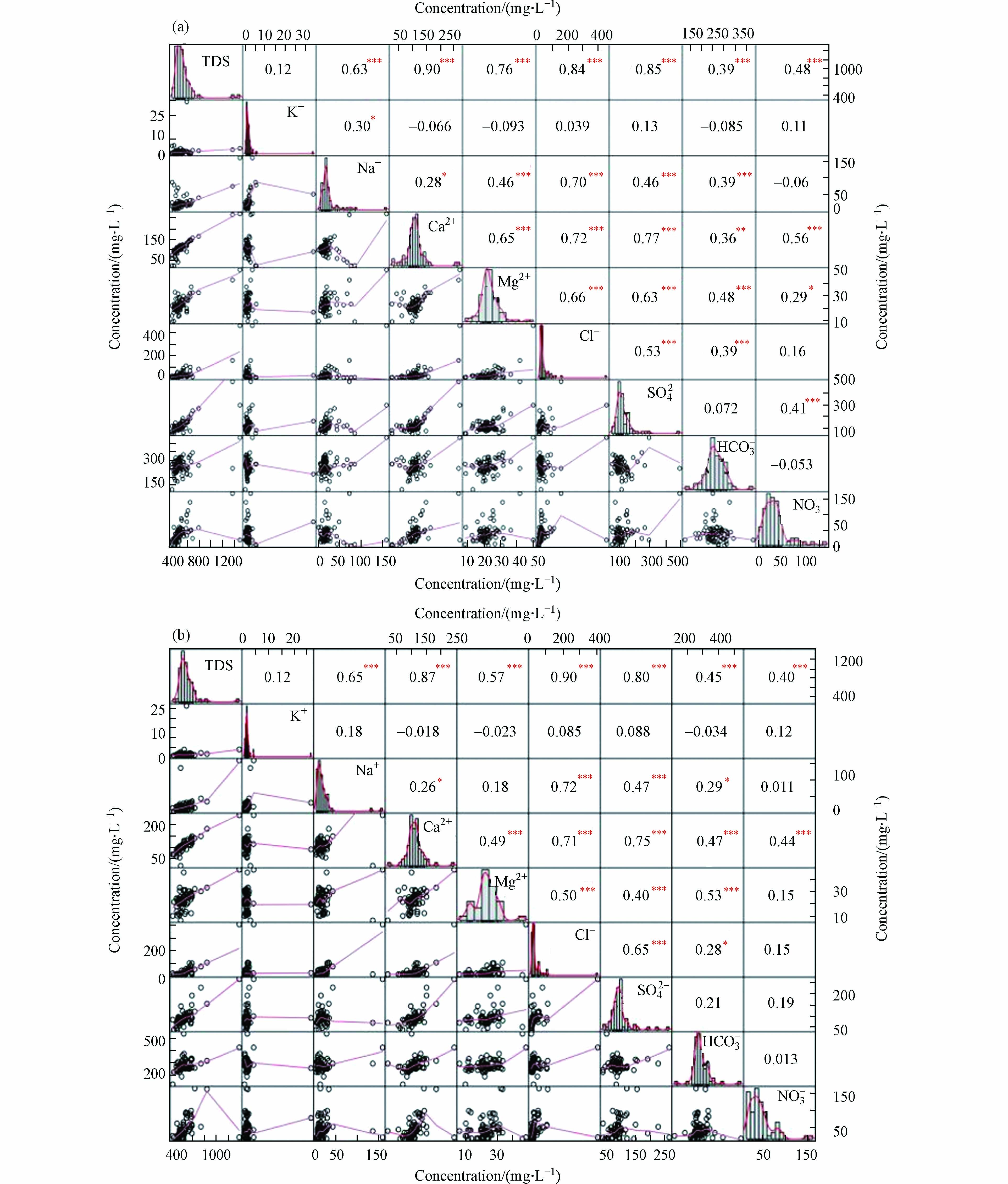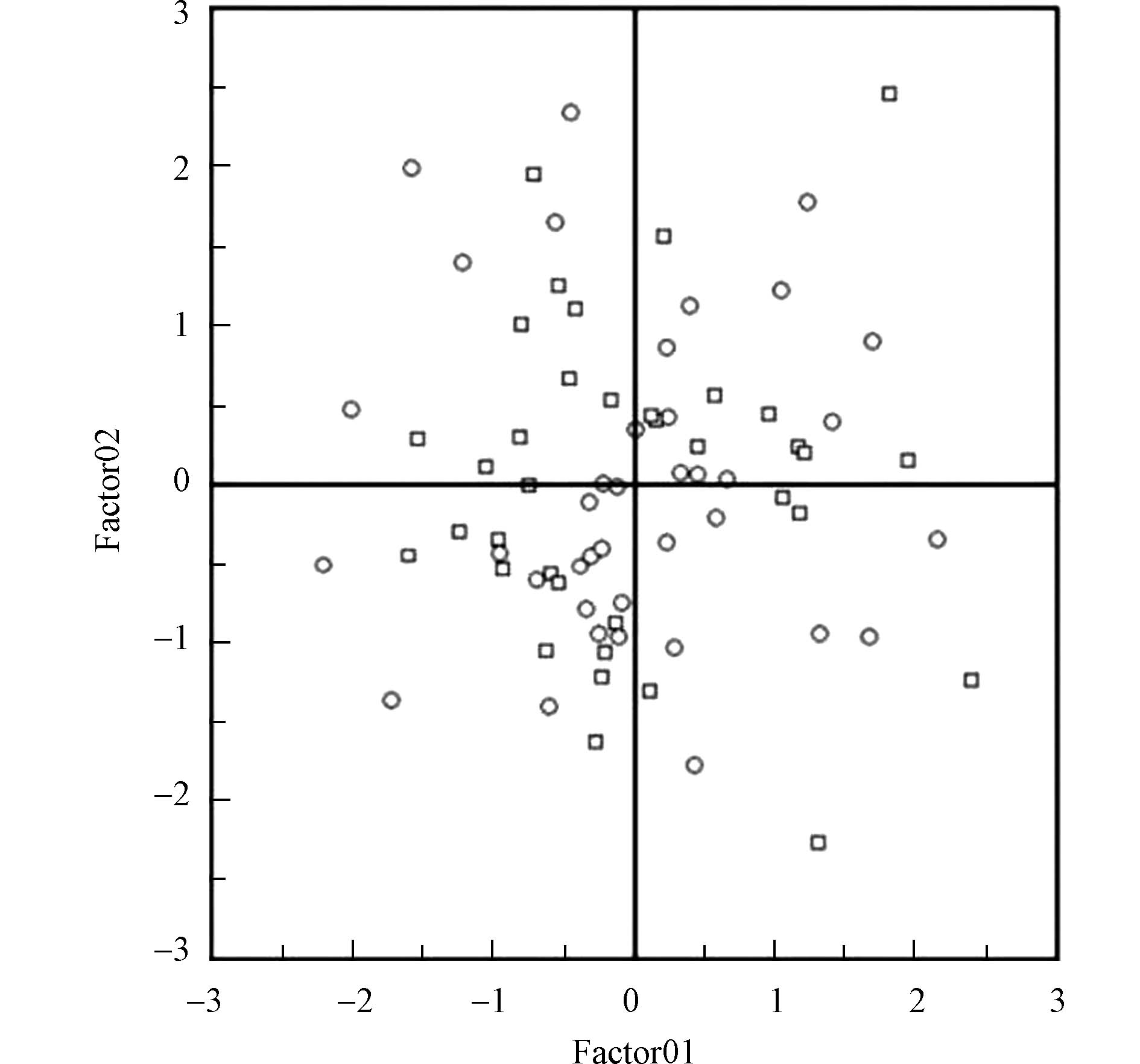-
我国北方岩溶水系统具有汇水面积广、多呈层状发育、输入输出水量稳定、水质良好等特点,为北方30多个地级市和100多个县级市生活用水及工农业生产提供了重要的水资源保障[1-2]. 岩溶地下水的化学成分是水在循环过程中与周围环境长期相互作用的产物,在水体的相互转化和运移过程中,主要受地层岩性、水文情势、大气输入以及人为作用的影响,同时伴随溶解物质相互转化[3-5]. 近年来,在气候变化和人类活动等叠加作用下,我国北方岩溶地下水水质呈恶化趋势,主要表现为水化学类型中重碳酸盐型水的占比逐渐下降,硫酸盐型水和其它类型水的占比增多,地下水中TDS、总硬度、硫酸盐、氯化物、硝酸盐等浓度不断增加. 人类工农业活动产生的“三废”,经降水冲刷进入到含水层是影响地下水水质的一个重要原因[6].
淄河流域岩溶地下水是淄博市及周边地区重要的供水水源,在地区经济可持续发展中发挥着不可替代的作用[7]. 20世纪80年代以来,随着经济的迅猛发展,流域地下水开采量大幅增加,水资源供需矛盾与环境问题日趋严重,特别是位于淄河下游的大武水源地,为我国北方特大型岩溶-裂隙地下水水源地,但由于受到当地石油化工企业的渗漏污染[8],水质恶化,人类活动已经成为影响该区域地下水化学组分的演化的重要因素[9-10]. 然而,以往学者对临淄大武水源地水质研究较多,而对淄河流域整体岩溶水系统水化学特征、控制因素及演化规律分析较少.
本文以淄河流域岩溶地下水为研究对象,利用2018年对区内70个岩溶水枯水期(6月)和丰水期(9月)采样化学分析数据,结合水文地质条件,对研究区地下水水化学特征进行分析,运用Gibbs图、离子比例系数、因子分析法探讨影响地下水组分的主要控制因素,对于识别岩溶水化学组分来源、判断水岩相互作用过程,了解淄河流域岩溶地下水环境现状,指导地下水合理开发利用具有较大的理论和实际意义.
-
研究区为淄河流域(图1),其东发源于鲁山北麓,西发源于禹王山东麓,自西南向东北流经博山、淄川、临淄三区,干流全长179.7 km,流域面积1397 km2,是淄博市主要的水系之一. 该区域属暖温带大陆型季风气候,多年平均气温12.2℃,区内多年平均降水量672.68 mm(1959—2018年),多年平均蒸发量2008 mm. 最大年降水量1118.7 mm(1964年),最小年降水量319.5 mm(2006年),降水量年内分布不均.
淄河流域地势南高北低,东西两侧分别为与弥河及孝妇河地表分水岭,南部为低山丘陵,向北逐渐降低为山前倾斜平原,地形低洼向北呈倾伏状. 中部分布南北向淄河断裂带[11],总体走向NE35°,主断裂倾向SE,倾角60°—70°. 自淄河上游太河水库建成蓄水以来,下游河道来水量锐减,绝大多数年份均断流干涸.
该流域水文地质分区属于淄河地堑及太河水库上游单斜构造水文地质小区,区内寒武—奥陶纪碳酸盐岩广泛分布,岩性以中厚层灰岩及白云岩为主,南部分水岭一带分布岩浆岩. 淄河河床由卵砾石、砂砾石等松散堆积物组成,渗漏能力极强[12],素有“淄河十八漏”之说. 沿淄河一带下伏奥陶系灰岩受断裂构造影响,裂隙岩溶发育,具有极强的渗透性,主要接受大气降水入渗和淄河河道渗漏补给,东、西、南三面地下水、地表水汇集后经淄河断裂带源源不断渗入地下,迅速补给岩溶地下水. 自淄河上游谢家店至下游大武一带分布多个具有强富水性的岩溶型地下水水源地,单井涌水量一般大于1000 m3·d−1,局部如大武、刘征水源地单井涌水量均大于5000 m3·d−1. 该流域地下水主要富水类型为碳酸盐岩类裂隙岩溶水,为本次取样研究主要目的含水层.
-
调查采样于2018年6月(枯水期)、9月(丰水期),共采集地下水样品70个(图1). 采样现场用水位计测定水位,用便携式HACH水质分析仪测定地下水的pH、电导率( EC) 、溶解氧(DO).
Na+ 、K+ 、Ca2+ 、Mg2+ 等阳离子测定通过电感耦合等离子体发射光谱仪(ICP-OES,OPTIMA 7000DV型),Cl− 、SO42− 、NO3− 浓等阴离子通过CIC-D120离子色谱仪完成,CO32− 、HCO3− 、TDS采用EDTA滴定法测定,通过主离子的浓度总和减去1/2HCO3− 计算得到溶解性总固体( TDS). 所有样品在山东省地矿工程勘察院实验室完成检测. -
测试完毕后,对水化学数据进行分析整理. 利用分析统计软件SPSS25.0对地下水水化学离子进行特征统计及因子分析;利用AQQA软件绘制piper三线图;利用excel软件绘制Gibbs图及离子比例关系图;利用R统计软件PerformanceAnalytics包进行相关性可视化分析.
-
对枯水期和丰水期地下水水化学成分及浓度进行特征统计,结果如表1所示. 总体而言,淄河流域岩溶地下水主要离子在枯水期、丰水期呈现一定的差异性. 地下水pH值处于7.1—8.3之间,呈弱碱性,变异系数较小,均值相差不大,季节差异不显著. 枯水期和丰水期TDS平均值分别为498.54 mg·L−1 、484.09 mg·L−1,丰水期TDS值略小于枯水期. 地下水中
Cl− 、Mg2+ 、HCO3− 、NO3− 平均质量浓度均表现为丰水期>枯水期,一般来说,降水进入含水层后会对地下水有稀释作用,而淄河流域相反,丰水期离子含量略高于枯水期,表明大气降水可能加快了岩石的溶滤作用,例如:碳酸盐岩的溶解会使得丰水期HCO3− 离子含量偏高;地表硝酸盐污染物随雨水入渗地下水中,可能导致NO3− 含量升高. 且由于区域水文地质条件差异性使得不同采样点水质具有较大的变化范围.Piper三线图可以用来分析岩溶地下水主要离子组成的总体特征及演化规律,该方法的优点是不受人为因素的影响,可以看出各离子的相对含量[13-14]. 由图2可知,该流域岩溶地下水以
HCO3−Ca 型及HCO3·SO4−Ca 型为主,不论枯、丰水期优势阴离子均为HCO3− ,分别占全部阴离子总量的45.65%—75.28%,50.25%—76.37%,其次为SO42− . 就阳离子而言,枯水期和丰水期的优势阳离子均为Ca2+ 离子,分别占全部阳离子总量的55.60%—81.71%,48.25%—81.40%,说明碳酸盐岩风化溶解是水化学组分的主要来源[15]. 究其原因是由于研究区岩溶发育较强,在灰岩的风化和溶滤作用下,致使该区地下水中HCO3− 、Ca2+ 普遍偏高. 根据前人研究,SO42− 主要来源于淄河上游寒武系灰岩石膏层、芒硝等的溶解及石马镇一带局部煤系地层黄铁矿(FeS2 )的氧化[16],近年来,SO42− 在地下水中占比逐渐增高[17],推测原因为人类开采活动加速了水岩作用过程.从研究区TDS等值线分布图(图3)可知,淄河流域岩溶地下水TDS自上游至下游呈增高的趋势,在博山区北博山镇、源泉镇、崮山镇一带及下游的临淄区南王镇、金岭回族镇等一带,居民及工农业密集,且分布多个地下水水源地,地下水TDS明显增高,主要影响离子为总硬度、
Cl− 、SO42− 、NO3− . 根据大武水源地供水水文地质勘探报告,淄河下游大武水源地一带在开采前的1977年TDS约200—360 mg·L−1,NO3− 浓度仅为4—6.8 mg·L−1;而至2018年枯、丰水期,该区域岩溶地下水中TDS含量已增加到510—650 mg·L−1,NO3− 含量已达38—55 mg·L−1,临淄区堠皋一带水质较差,TDS超过1000 mg·L−1、总硬度、Cl− 、SO42− 含量均明显高于流域其它地区,这固有地下水从补给区到排泄区TDS自然增高的因素,但更主要是由于该区域石油化工企业密集,工业活动较频繁[18],人类活动已经对地下水水质产生显著影响. -
Gibbs(1970)模型能够清楚地表示出控制地下水化学成分的自然来源以及水化学形成机制,其中形成机制分为降水作用机制、岩石风化机制以及蒸发浓缩机制[19-20].
从研究区岩溶地下水的Gibbs图4可知,枯、丰水期地下水样品TDS介于335—1495 mg·L−1、294—1370 mg·L−1,
Na+/(Na++Ca2+) 比值分别在0.01—0.74、0.05—0.88范围内,Cl−/(Cl−+HCO−3) 比值分别在0.03—0.51、0.02—0.38范围内. 枯水期、丰水期采样点在均分布在岩石风化控制区附近,并远离降水控制型区域. 这表明该流域岩溶地下水离子组分主要受岩石风化作用控制. 该区分布多个地下水水源地,开采量较大,地下水水位埋深较深,受大气降雨和蒸发的作用较小,但受构造条件的影响,裂隙岩溶发育,为岩石的风化提供了有利条件. 由于地下水离子来源的广泛性和复杂性,需要通过其他方法进一步深入探讨. -
相关分析是研究不同变量相关性的数理统计方法,将相关性可视化可清楚地看出变量之间的相关性强弱,从而有效的揭示地下水主要组分来源的一致性和差异性[21-22]. 相关性分析可视化结果如图5所示,图中对角线是变量自身的分布;对角线右上方表示两个属性的相关性值,星号表示显著程度,*在0.05 级别(双侧),相关性显著,**表示在 0.01 级别(双侧),相关性显著;对角线的左下方是两个属性的散点图.
TDS与各离子相关关系能较好反映地下水的成因. 由图5可知,除
K+ 外,TDS与各离子之间均呈显著相关. 在枯水期,Ca2+ 与TDS相关性最强(r=0.90),其次为SO42− 、Cl− 、Mg2+ (r>0.7),NO−3 、HCO−3 相关系数分别为0.48、0.39;在丰水期,Cl− 与TDS相关性最强(r=0.90),其次为Ca2+ 、SO42− ,表明研究区地下水主要离子的来源可能与广泛分布的灰岩、白云岩等可溶性碳酸盐岩的溶解有关. 在枯水期主要以碳酸盐岩溶解为主,到丰水期地下水位抬升,增加了岩盐、硫酸盐等矿物的溶解.Na+ 与Cl− 相关性最好(r≈0.71),其次为SO42− ,表明Na+ 的来源与Cl− 具有相似性,可能与岩盐矿物的溶解有关;Ca2+ 与SO42− 相关性最好(r≈0.76)、其次为Cl− 、Mg2+ 、NO−3 ,说明除白云岩水岩作用、石膏矿物溶解以外,部分Ca2+ 的来源与含Cl− 、NO−3 的污染物入渗有关.Mg2+ 和SO42− 相关性(r=0.63、0.40)表明存在脱白云石化作用. 由于石膏溶解未达到饱和,水中Ca2+ 浓度增加,并产生含SO42− 溶液,白云石中Mg2+ 被Ca2+ 置换产生方解石沉淀,发生脱白云石化. -
相比于传统的水化学类型分析方法,分析水化学组分的比例关系特征更能有效的判断地下水的成因、水化学成分的来源及演化过程[23]. 假设岩溶地下水中
Ca2+ 、Mg2+ 主要来自方解石、白云石、石膏的溶解及蒸发岩的溶解,所以可用(Ca2++Mg2+) 与(HCO−3 +SO42− )摩尔浓度关系来判断Ca2+ 、Mg2+ 的主要来源. 方解石、白云石和石膏的溶解方程如下:若地下水中相关离子主要来源于方解石、白云石和石膏的溶解,则水中
(Ca2++Mg2+) 与(HCO−3 +SO42− )的毫克当量比应该接近1:1[24],由图6(a)可以看出,研究区岩溶地下水在枯、丰水期绝大部分采样点位于1:1直线上侧,说明地下水中溶解组分季节差异较小,主要与地质背景条件有关,地下水中Ca2+ 和Mg2+ 组分主要来源于碳酸盐岩的溶解作用. 位于1:1直线下侧的点位主要分布在太河乡、太河水库下游附近,说明可能伴随着硅酸盐岩和蒸发岩的溶解作用[25].K+ 、Na+ 和Cl− 主要来源于大气降水、生活废水、农业施肥和盐岩的溶解[26]. 当盐岩溶解起主导作用时,(K++Na+) 与Cl− 的比值应为1:1[27].(K++Na+) 与Cl− 的关系如图6(b)所示,可见K+ 、Na+ 和Cl− 受季节影响较大. 枯水期采样点大部分位于1:1直线上方,说明枯水期时该区主要存在盐岩溶解作用和铝硅酸盐矿物的溶滤. 丰水期采样点大部分位于1:1直线下方,说明丰水期时地下水中Cl− 可能有其他来源,如生活污水和农业面源污染等.通常用
[(Ca2++Mg2+)−(HCO−3+SO2−4)] 与[(Na++K+)−Cl− ]的关系来研究地下水中阳离子交换作用,[(Ca2++Mg2+)−(HCO−3+SO2−4)] 表示除石膏、方解石和白云石溶解外所带来的Ca2+ 和Mg2+ 的增加和减少量,[(Na++K+)−Cl− ]表示除岩盐溶解外所带来的Na+ 的增加或减少量[28]. 如果[(Ca2++Mg2+)−(HCO−3+SO2−4)] 与[(Na++K+)−Cl− ]呈显著负相关关系,那么各采样点均落在斜线-1的直线附近,表明地下水在径流过程中发生了阳离子交换作用.由图6(c)可见,大部分水样点落在斜线-1的直线附近及上方,这说明研究区地下水中存在阳离子交换作用,水中
Ca2+ 和Mg2+ 会把岩土中吸附的Na+ 和K+ 置换出来,再结合由相关性的可视化图3中可知,Ca2+ 与Na+ 、Mg2+ 与Na+ 的相关系数分别为0.26和 0.18,相关性不显著,说明阳离子交换作用在地下水化学组分构成中起到不可忽视的作用.有研究表明
NO−3 、Cl− 来源于含水层介质的溶解较少,参与大规模的离子交换反应也不多,而主要来自人类活动产生的生活污水、农业无机化肥的使用及人畜粪便[29]. 由图6(d)以及相关性可视化图可知,NO−3 与Cl− 相关性不显著,说明它们有各自不同来源,可能来自生活污水和农业活动等不同的污染物. -
影响地下水水化学组分的变量很多,变量研究已经广泛用于地下水水化学组成及影响因素,而因子分析能用几个变量反映多个变量的内在的联系和本质特征[30-31]. 通过对研究区岩溶地下水中主要阴阳离子(
Na+ 、K+ 、Mg2+ 、Ca2+ 、Cl− 、SO2−4 、HCO−3 、NO−3 )进行KMO 检验和Bartlett 球形检验统计,检验结果显示,枯、丰水期KMO 检验取值分别为0.516和0.521,Bartlett 球形检验统计量的 Sig值均为零(Sig=0<0.01),有研究表明 KMO统计量在 0.5 以上,Bartlett 球形检验统计量的Sig=0(<0.01) 时,因子分析法可用于分析初始变量内在联系. 因此选取研究区地下水中主要的阴阳离子(Na+ 、K+ 、Mg2+ 、Ca2+ 、Cl− 、SO2−4 、HCO−3 、NO−3 )进行主成分分析和因子分析,通过分析结果进一步把握研究区自然条件和人为活动等因素对地下水水化学组成的影响[32]. 将主成分分析和因子分析进行整理,其分析结果如表2、3所示.以特征值大于1为提取原则,符合要求的共三个主成分,提取分析结果共同解释了原数据74.567%的方差. 丰水期时,第1主成分解释了37.21%的方差,该成分的主要贡献者是
Ca2+ 、SO2−4 、HCO−3 ,反映了以方解石和石膏等碳酸盐溶解对岩溶地下水组分的影响. 第2主成分的解释了21.38%的方差,该成分的主要贡献者是Na+ 、K+ 、Cl− 、NO−3 ,反映了人为活动和大气输出的影响. 第3主成分解释了15.98%的方差,该成分的主要贡献者是Mg2+ ,反映了白云岩溶解以及脱白云石化等水岩作用. 故可认为研究区地下水水化学组分和演化进程主要受到这三种因素的影响.结合因子的得分图7和采样点的分布情况可以直观解释第1因子、第2因子与原变量的关系,较好的反映采样点离子的来源与影响因素. 总体而言,枯水期、丰水期的地下水在图中分布均匀,但分布在左下角较多,枯、丰水期均占到34.21%. 左下角地下水离子的因子的第1、2因子得分为负值,说明第1、2因子影响较小,结合采样图可知采样位于淄河支流与淄河交汇的上游、太河水库及仁河水库下游,在交汇的河流段长度不长,水岩作用时间短,加之水库周围保护措施较好,人为活动影响较小;左上角第1因子为负值,第2因子为正值,说明地下水化学组分是由第2因子代表的人为活动和大气输出的影响所控制的,采样点分别位于陡沟村、拔子村以及淄河下游的南仇村至前李官庄村河段. 枯、丰水期分布于右下角水样较少,只分别占到18.42%、13.16%,右下角第1因子为正,第2因子为负,则主要由第1因子代表的碳酸盐溶解的影响所控制,采样点分布也较散,无规律可循. 右上角第1因子为正,第2因子为正,则由碳酸盐溶解、人为活动和大气输出影响共同控制,这些采样点位于淄河上游,上游有谢家店水源地、源泉水源地等.
-
(1)研究区岩溶地下水枯水期和丰水期的TDS平均值分别为498.54 mg·L−1 、484.09 mg·L−1,丰水期TDS值略小于枯水期. 在地下水中
Cl− 、Mg2+ 、HCO−3 、NO−3 平均质量浓度均表现为丰水期>枯水期. 一般来说,降水进入含水层后会对地下水有稀释作用,但淄河流域相反,丰水期离子含量略高于枯水期,表明降水作用加快了岩石的溶滤作用.(2)分析piper三线图可知,淄河流域岩溶地下水水化学类型以
HCO3−Ca 型及HCO3·SO4−Ca 型为主. TDS自上游至下游呈增高的趋势,符合地下水演化自然规律. 但在乡镇一带居民及工农业聚集区,TDS明显增高,主要影响离子为总硬度、Cl− 、SO2−4 、NO−3 . 淄河下游临淄区堠皋一带,水质较差,反映化工企业对该区域地下水水质造成影响.(3)运用Gibbs模型及相关性分析等方法得出,淄河流域岩溶地下水离子组分主要受岩石风化作用控制,与广泛分布的灰岩、白云岩等可溶性碳酸盐岩的溶解有关. 在枯水期主要以碳酸盐岩溶解为主,到丰水期地下水位抬升,增加了岩盐、硫酸盐等矿物的溶解. 地下水中存在脱白云石化作用.
(4)运用离子比例分析可知,岩溶地下水中
Ca2+ 和Mg2+ 组分主要来源于碳酸盐岩的溶解作用;Cl− 、NO−3 受人类活动影响较大,可能来自生活污水和农业活动等不同的污染物,并且丰水期加速了污染物质的溶解;阳离子交换作用在地下水化学组分构成中起到不可忽视的作用.(5)因子分析法提取了三个主因子,能够较好地解释淄河流域岩溶水的主要影响因素. 第1主成份主要贡献者是
Ca2+ 、SO2−4 、HCO−3 ,反映了方解石和石膏等碳酸盐溶解对岩溶地下水组分的影响,贡献率37.21%;第2主成分主要贡献者是Na+ 、K+ 、Cl− 、NO−3 ,反映了人为活动和大气输出的影响,贡献率21.38%;第3主成分主要贡献者是Mg2+ ,反映了白云岩溶解以及脱白云石化等水岩作用对岩溶地下水组分的影响,贡献率15.98%.
淄河流域岩溶地下水化学特征及控制因素分析
Analysis on hydrochemical characteristics and controlling factors of karst groundwater in Zihe River Basin
-
摘要: 选取淄河流域2018年枯水期及丰水期各采集的70件地下水样品,综合运用水化学(piper三线图、Gibbs模型、相关性分析、离子比例分析)和多元统计分析(主成分分析、因子分析)方法,探讨了该流域岩溶地下水化学特征及控制因素. 结果表明:(1)流域岩溶地下水化学类型以
HCO3−Ca 型及HCO3⋅SO4−Ca 型为主,化学组分主要来源于广泛分布的灰岩、白云岩等可溶性碳酸盐岩,并受岩石风化程度能力控制. 丰水期地下水位抬升,增加了岩盐、硫酸盐等矿物的溶解. (2)沿淄河乡镇一带居民及工农业聚集区,地下水TDS明显增高,主要影响离子为总硬度、Cl− 、SO2−4 、NO−3 . 淄河下游临淄区堠皋一带,水质较差,反映化工企业对该区域地下水水质造成影响. (3)Cl− 、NO−3 受人类活动影响较大,可能来自生活污水和农业活动等不同的污染物,并且丰水期加速了污染物质的溶解. (4)水岩作用因子分析反映出方解石和石膏等溶解、工农业生产生活、白云岩溶解等对水化学组分影响,贡献率分别为37.21%、21.38%、15.98%.Abstract: Select Zihe river basin during 2018 dry season and the wet season collection of 70 samples of groundwater, the integrated use of water chemistry (Piper three-line diagram, Gibbs model, correlation analysis, ion ratio analysis) and multivariate statistical analysis (principal component analysis, factor analysis) method, discusses the karst groundwater chemical characteristics and control factors of the basin. The results show that: (1) the hydrochemical types of karst groundwater in the basin are mainly HCO3-Ca and HCO3·SO4-Ca, and the chemical components mainly come from widely distributed soluble carbonate rocks such as limestone and dolomite, and are controlled by the degree of rock weathering. The rise of groundwater level during wet season increases the dissolution of rock salt, sulfate and other minerals. (2) Along Zihe Township, residents and industrial and agricultural gathering areas, the TDS of groundwater increases significantly, and the main influencing ions are total hardness, chloride, sulfate, nitrate.The water quality in Hougao area of Linzi District in the lower reaches of Zihe River is poor, which reflects the impact of chemical enterprises on the groundwater quality in this area. (3) Chloride and nitrate are greatly affected by human activities and may come from different pollutants such as domestic sewage and agricultural activities, and the dissolution of pollutants is accelerated in wet season. (4) The factor analysis of water rock interaction reflects the influence of calcite and gypsum dissolution, industrial and agricultural production and life, dolomite dissolution on hydrochemical components, and the contribution rates are 37.21%, 21.38% and 15.98% respectively.-
Key words:
- Zihe River Basin /
- karst groundwater /
- hydrochemistry /
- principal component analysis.
-
我国北方岩溶水系统具有汇水面积广、多呈层状发育、输入输出水量稳定、水质良好等特点,为北方30多个地级市和100多个县级市生活用水及工农业生产提供了重要的水资源保障[1-2]. 岩溶地下水的化学成分是水在循环过程中与周围环境长期相互作用的产物,在水体的相互转化和运移过程中,主要受地层岩性、水文情势、大气输入以及人为作用的影响,同时伴随溶解物质相互转化[3-5]. 近年来,在气候变化和人类活动等叠加作用下,我国北方岩溶地下水水质呈恶化趋势,主要表现为水化学类型中重碳酸盐型水的占比逐渐下降,硫酸盐型水和其它类型水的占比增多,地下水中TDS、总硬度、硫酸盐、氯化物、硝酸盐等浓度不断增加. 人类工农业活动产生的“三废”,经降水冲刷进入到含水层是影响地下水水质的一个重要原因[6].
淄河流域岩溶地下水是淄博市及周边地区重要的供水水源,在地区经济可持续发展中发挥着不可替代的作用[7]. 20世纪80年代以来,随着经济的迅猛发展,流域地下水开采量大幅增加,水资源供需矛盾与环境问题日趋严重,特别是位于淄河下游的大武水源地,为我国北方特大型岩溶-裂隙地下水水源地,但由于受到当地石油化工企业的渗漏污染[8],水质恶化,人类活动已经成为影响该区域地下水化学组分的演化的重要因素[9-10]. 然而,以往学者对临淄大武水源地水质研究较多,而对淄河流域整体岩溶水系统水化学特征、控制因素及演化规律分析较少.
本文以淄河流域岩溶地下水为研究对象,利用2018年对区内70个岩溶水枯水期(6月)和丰水期(9月)采样化学分析数据,结合水文地质条件,对研究区地下水水化学特征进行分析,运用Gibbs图、离子比例系数、因子分析法探讨影响地下水组分的主要控制因素,对于识别岩溶水化学组分来源、判断水岩相互作用过程,了解淄河流域岩溶地下水环境现状,指导地下水合理开发利用具有较大的理论和实际意义.
1. 材料与方法(Materials and methods)
1.1 研究区概况
研究区为淄河流域(图1),其东发源于鲁山北麓,西发源于禹王山东麓,自西南向东北流经博山、淄川、临淄三区,干流全长179.7 km,流域面积1397 km2,是淄博市主要的水系之一. 该区域属暖温带大陆型季风气候,多年平均气温12.2℃,区内多年平均降水量672.68 mm(1959—2018年),多年平均蒸发量2008 mm. 最大年降水量1118.7 mm(1964年),最小年降水量319.5 mm(2006年),降水量年内分布不均.
淄河流域地势南高北低,东西两侧分别为与弥河及孝妇河地表分水岭,南部为低山丘陵,向北逐渐降低为山前倾斜平原,地形低洼向北呈倾伏状. 中部分布南北向淄河断裂带[11],总体走向NE35°,主断裂倾向SE,倾角60°—70°. 自淄河上游太河水库建成蓄水以来,下游河道来水量锐减,绝大多数年份均断流干涸.
该流域水文地质分区属于淄河地堑及太河水库上游单斜构造水文地质小区,区内寒武—奥陶纪碳酸盐岩广泛分布,岩性以中厚层灰岩及白云岩为主,南部分水岭一带分布岩浆岩. 淄河河床由卵砾石、砂砾石等松散堆积物组成,渗漏能力极强[12],素有“淄河十八漏”之说. 沿淄河一带下伏奥陶系灰岩受断裂构造影响,裂隙岩溶发育,具有极强的渗透性,主要接受大气降水入渗和淄河河道渗漏补给,东、西、南三面地下水、地表水汇集后经淄河断裂带源源不断渗入地下,迅速补给岩溶地下水. 自淄河上游谢家店至下游大武一带分布多个具有强富水性的岩溶型地下水水源地,单井涌水量一般大于1000 m3·d−1,局部如大武、刘征水源地单井涌水量均大于5000 m3·d−1. 该流域地下水主要富水类型为碳酸盐岩类裂隙岩溶水,为本次取样研究主要目的含水层.
1.2 样品采集与分析方法
调查采样于2018年6月(枯水期)、9月(丰水期),共采集地下水样品70个(图1). 采样现场用水位计测定水位,用便携式HACH水质分析仪测定地下水的pH、电导率( EC) 、溶解氧(DO).
Na+ K+ Ca2+ Mg2+ Cl− SO42− NO3− CO32− HCO3− HCO3− 1.3 数据统计与分析
测试完毕后,对水化学数据进行分析整理. 利用分析统计软件SPSS25.0对地下水水化学离子进行特征统计及因子分析;利用AQQA软件绘制piper三线图;利用excel软件绘制Gibbs图及离子比例关系图;利用R统计软件PerformanceAnalytics包进行相关性可视化分析.
2. 结果与讨论(Results and discussion)
2.1 地下水水化学特征分析
对枯水期和丰水期地下水水化学成分及浓度进行特征统计,结果如表1所示. 总体而言,淄河流域岩溶地下水主要离子在枯水期、丰水期呈现一定的差异性. 地下水pH值处于7.1—8.3之间,呈弱碱性,变异系数较小,均值相差不大,季节差异不显著. 枯水期和丰水期TDS平均值分别为498.54 mg·L−1 、484.09 mg·L−1,丰水期TDS值略小于枯水期. 地下水中
Cl− Mg2+ HCO3− NO3− HCO3− NO3− 表 1 淄河流域岩溶地下水主要离子含量统计值Table 1. Statistical values of main ions in karst groundwater of Zihe River Basin项目Item pH TDS/(mg·L−1) 水化学/(mg·L−1)Hydrochemisty K+ Na+ Ca2+ Mg2+ Cl− SO42− HCO3− NO3− 枯水期 最大值 8.40 1495.0 33.79 160.0 270.66 50.12 456.73 494.87 433.78 166.35 最小值 7.10 335.0 0.16 1.66 26.25 8.99 8.52 48.13 124.78 0.10 平均值 7.63 498.54 1.90 23.84 108.92 22.97 36.80 119.79 262.41 40.50 标准差 0.28 185.97 3.99 23.65 37.78 6.62 57.25 65.00 45.28 29.98 变异系数 0.04 0.37 2.10 0.99 0.35 0.29 1.56 0.54 0.17 0.74 丰水期 最大值 7.72 1370.0 26.60 161.0 245.00 48.10 404.00 266.00 542.00 162.00 最小值 7.05 294.0 0.40 5.00 19.00 6.30 11.90 37.60 119.00 14.30 平均值 7.47 484.09 1.73 20.70 107.89 23.18 37.63 92.87 280.63 44.57 标准差 0.12 146.44 3.13 24.17 29.71 7.51 50.41 37.31 54.51 29.74 变异系数 0.02 0.30 1.81 1.17 0.28 0.26 1.34 0.40 0.19 0.67 Piper三线图可以用来分析岩溶地下水主要离子组成的总体特征及演化规律,该方法的优点是不受人为因素的影响,可以看出各离子的相对含量[13-14]. 由图2可知,该流域岩溶地下水以
HCO3−Ca HCO3·SO4−Ca HCO3− SO42− Ca2+ HCO3− Ca2+ SO42− FeS2 SO42− 从研究区TDS等值线分布图(图3)可知,淄河流域岩溶地下水TDS自上游至下游呈增高的趋势,在博山区北博山镇、源泉镇、崮山镇一带及下游的临淄区南王镇、金岭回族镇等一带,居民及工农业密集,且分布多个地下水水源地,地下水TDS明显增高,主要影响离子为总硬度、
Cl− SO42− NO3− NO3− NO3− Cl− SO42− 2.2 地下水水化学组分的影响因素Gibbs分析
Gibbs(1970)模型能够清楚地表示出控制地下水化学成分的自然来源以及水化学形成机制,其中形成机制分为降水作用机制、岩石风化机制以及蒸发浓缩机制[19-20].
从研究区岩溶地下水的Gibbs图4可知,枯、丰水期地下水样品TDS介于335—1495 mg·L−1、294—1370 mg·L−1,
Na+/(Na++Ca2+) Cl−/(Cl−+HCO−3) 2.3 地下水水化学组分相关性分析
相关分析是研究不同变量相关性的数理统计方法,将相关性可视化可清楚地看出变量之间的相关性强弱,从而有效的揭示地下水主要组分来源的一致性和差异性[21-22]. 相关性分析可视化结果如图5所示,图中对角线是变量自身的分布;对角线右上方表示两个属性的相关性值,星号表示显著程度,*在0.05 级别(双侧),相关性显著,**表示在 0.01 级别(双侧),相关性显著;对角线的左下方是两个属性的散点图.
TDS与各离子相关关系能较好反映地下水的成因. 由图5可知,除
K+ Ca2+ SO42− Cl− Mg2+ NO−3 HCO−3 Cl− Ca2+ SO42− Na+ Cl− SO42− Na+ Cl− Ca2+ SO42− Cl− Mg2+ NO−3 Ca2+ Cl− NO−3 Mg2+ SO42− Ca2+ SO42− Mg2+ Ca2+ 2.4 地下水离子比例分析
相比于传统的水化学类型分析方法,分析水化学组分的比例关系特征更能有效的判断地下水的成因、水化学成分的来源及演化过程[23]. 假设岩溶地下水中
Ca2+ Mg2+ (Ca2++Mg2+) (HCO−3 SO42− Ca2+ Mg2+ CaCO3+CO2(g)+H2O=Ca2++2HCO−3 (1) CaMg(CO3)2+2CO2(g)+2H2O=Ca2++Mg2++2HCO−3 (2) CaSO4⋅2H2O=Ca2++SO42−+2H2O (3) CaCO3+CaMg(CO3)2+3CO2(g)+3H2O=2Ca2++Mg2++6HCO−3 (4) 若地下水中相关离子主要来源于方解石、白云石和石膏的溶解,则水中
(Ca2++Mg2+) (HCO−3 SO42− Ca2+ Mg2+ K+ Na+ Cl− (K++Na+) Cl− (K++Na+) Cl− K+ Na+ Cl− Cl− 通常用
[(Ca2++Mg2+)−(HCO−3+SO2−4)] [(Na++K+)−Cl− [(Ca2++Mg2+)−(HCO−3+SO2−4)] Ca2+ Mg2+ [(Na++K+)−Cl− Na+ [(Ca2++Mg2+)−(HCO−3+SO2−4)] [(Na++K+)−Cl− 由图6(c)可见,大部分水样点落在斜线-1的直线附近及上方,这说明研究区地下水中存在阳离子交换作用,水中
Ca2+ Mg2+ Na+ K+ Ca2+ Na+ Mg2+ Na+ 有研究表明
NO−3 Cl− NO−3 Cl− 2.5 地下水影响因素主成分分析及因子分析
影响地下水水化学组分的变量很多,变量研究已经广泛用于地下水水化学组成及影响因素,而因子分析能用几个变量反映多个变量的内在的联系和本质特征[30-31]. 通过对研究区岩溶地下水中主要阴阳离子(
Na+ K+ Mg2+ Ca2+ Cl− SO2−4 HCO−3 NO−3 Na+ K+ Mg2+ Ca2+ Cl− SO2−4 HCO−3 NO−3 表 2 地下水主要离子主成分方差可解释量Table 2. Interpretable quantities of principal component variance of main ions in groundwater成分Component 初始特征值Initial eigenvalue 提取载荷平方和Extracting load sum of squares 旋转载荷平方和Quadratic sum of rotational loads 总计 方差% 累积% 总计 方差% 累积% 总计 方差% 累积% 1 2.604 37.207 37.207 2.604 37.207 37.207 2.058 29.401 29.401 2 1.497 21.385 58.592 1.497 21.385 58.592 1.904 27.203 56.604 3 1.118 15.976 74.567 1.118 15.976 74.567 1.257 17.963 74.567 4 0.795 11.362 85.930 5 0.481 6.866 92.796 6 0.386 5.510 98.306 7 0.119 1.694 100.000 提取方法:主成分分析法. 表 3 地下水主要离子旋转后的成分矩阵Table 3. Composition matrix of main ions in groundwater after rotation变量 Variable 成分Component 1 2 3 Na++K+ −0.228 0.733 −0.319 Mg2+ −0.096 0.088 0.951 Ca2+ 0.902 0.291 −0.055 Cl− 0.355 0.748 0.155 SO2−4 0.709 0.217 −0.153 HCO−3 0.661 −0.250 0.414 NO−3 0.342 0.778 0.170 提取方法:主成分分析法. 旋转方法:Kaiser正态化最大方差法. 以特征值大于1为提取原则,符合要求的共三个主成分,提取分析结果共同解释了原数据74.567%的方差. 丰水期时,第1主成分解释了37.21%的方差,该成分的主要贡献者是
Ca2+ SO2−4 HCO−3 Na+ K+ Cl− NO−3 Mg2+ 结合因子的得分图7和采样点的分布情况可以直观解释第1因子、第2因子与原变量的关系,较好的反映采样点离子的来源与影响因素. 总体而言,枯水期、丰水期的地下水在图中分布均匀,但分布在左下角较多,枯、丰水期均占到34.21%. 左下角地下水离子的因子的第1、2因子得分为负值,说明第1、2因子影响较小,结合采样图可知采样位于淄河支流与淄河交汇的上游、太河水库及仁河水库下游,在交汇的河流段长度不长,水岩作用时间短,加之水库周围保护措施较好,人为活动影响较小;左上角第1因子为负值,第2因子为正值,说明地下水化学组分是由第2因子代表的人为活动和大气输出的影响所控制的,采样点分别位于陡沟村、拔子村以及淄河下游的南仇村至前李官庄村河段. 枯、丰水期分布于右下角水样较少,只分别占到18.42%、13.16%,右下角第1因子为正,第2因子为负,则主要由第1因子代表的碳酸盐溶解的影响所控制,采样点分布也较散,无规律可循. 右上角第1因子为正,第2因子为正,则由碳酸盐溶解、人为活动和大气输出影响共同控制,这些采样点位于淄河上游,上游有谢家店水源地、源泉水源地等.
3. 结论(Conclusion)
(1)研究区岩溶地下水枯水期和丰水期的TDS平均值分别为498.54 mg·L−1 、484.09 mg·L−1,丰水期TDS值略小于枯水期. 在地下水中
Cl− Mg2+ HCO−3 NO−3 (2)分析piper三线图可知,淄河流域岩溶地下水水化学类型以
HCO3−Ca HCO3·SO4−Ca Cl− SO2−4 NO−3 (3)运用Gibbs模型及相关性分析等方法得出,淄河流域岩溶地下水离子组分主要受岩石风化作用控制,与广泛分布的灰岩、白云岩等可溶性碳酸盐岩的溶解有关. 在枯水期主要以碳酸盐岩溶解为主,到丰水期地下水位抬升,增加了岩盐、硫酸盐等矿物的溶解. 地下水中存在脱白云石化作用.
(4)运用离子比例分析可知,岩溶地下水中
Ca2+ Mg2+ Cl− NO−3 (5)因子分析法提取了三个主因子,能够较好地解释淄河流域岩溶水的主要影响因素. 第1主成份主要贡献者是
Ca2+ SO2−4 HCO−3 Na+ K+ Cl− NO−3 Mg2+ -
表 1 淄河流域岩溶地下水主要离子含量统计值
Table 1. Statistical values of main ions in karst groundwater of Zihe River Basin
项目Item pH TDS/(mg·L−1) 水化学/(mg·L−1)Hydrochemisty K+ Na+ Ca2+ Mg2+ Cl− SO42− HCO3− NO3− 枯水期 最大值 8.40 1495.0 33.79 160.0 270.66 50.12 456.73 494.87 433.78 166.35 最小值 7.10 335.0 0.16 1.66 26.25 8.99 8.52 48.13 124.78 0.10 平均值 7.63 498.54 1.90 23.84 108.92 22.97 36.80 119.79 262.41 40.50 标准差 0.28 185.97 3.99 23.65 37.78 6.62 57.25 65.00 45.28 29.98 变异系数 0.04 0.37 2.10 0.99 0.35 0.29 1.56 0.54 0.17 0.74 丰水期 最大值 7.72 1370.0 26.60 161.0 245.00 48.10 404.00 266.00 542.00 162.00 最小值 7.05 294.0 0.40 5.00 19.00 6.30 11.90 37.60 119.00 14.30 平均值 7.47 484.09 1.73 20.70 107.89 23.18 37.63 92.87 280.63 44.57 标准差 0.12 146.44 3.13 24.17 29.71 7.51 50.41 37.31 54.51 29.74 变异系数 0.02 0.30 1.81 1.17 0.28 0.26 1.34 0.40 0.19 0.67 表 2 地下水主要离子主成分方差可解释量
Table 2. Interpretable quantities of principal component variance of main ions in groundwater
成分Component 初始特征值Initial eigenvalue 提取载荷平方和Extracting load sum of squares 旋转载荷平方和Quadratic sum of rotational loads 总计 方差% 累积% 总计 方差% 累积% 总计 方差% 累积% 1 2.604 37.207 37.207 2.604 37.207 37.207 2.058 29.401 29.401 2 1.497 21.385 58.592 1.497 21.385 58.592 1.904 27.203 56.604 3 1.118 15.976 74.567 1.118 15.976 74.567 1.257 17.963 74.567 4 0.795 11.362 85.930 5 0.481 6.866 92.796 6 0.386 5.510 98.306 7 0.119 1.694 100.000 提取方法:主成分分析法. 表 3 地下水主要离子旋转后的成分矩阵
Table 3. Composition matrix of main ions in groundwater after rotation
变量 Variable 成分Component 1 2 3 Na++K+ −0.228 0.733 −0.319 Mg2+ −0.096 0.088 0.951 Ca2+ 0.902 0.291 −0.055 Cl− 0.355 0.748 0.155 SO2−4 0.709 0.217 −0.153 HCO−3 0.661 −0.250 0.414 NO−3 0.342 0.778 0.170 提取方法:主成分分析法. 旋转方法:Kaiser正态化最大方差法. -
[1] 梁永平, 申豪勇, 赵春红, 等. 对中国北方岩溶水研究方向的思考与实践 [J]. 中国岩溶, 2021, 40(3): 363-380. LIANG Y P, SHEN H Y, ZHAO C H, et al. Thinking and practice on the research direction of Karst water in Northern China [J]. Carsologica Sinica, 2021, 40(3): 363-380(in Chinese).
[2] 吴潇. 柳林泉岩溶水系统水文地球化学演化及污染溯源研究[D]. 武汉: 中国地质大学, 2021. WU X. Hydrogeochemical evolution and pollution tracing in Liulin Karst water system[D]. Wuhan: China University of Geosciences, 2021(in Chinese).
[3] 寇永朝, 华琨, 李洲, 等. 泾河支流地表水地下水的水化学特征及其控制因素 [J]. 环境科学, 2018, 39(7): 3142-3149. KOU Y C, HUA K, LI Z, et al. Major ionic features and their possible controls in the surface water and groundwater of the Jinghe River [J]. Environmental Science, 2018, 39(7): 3142-3149(in Chinese).
[4] HINDSHAW R S, TIPPER E T, REYNOLDS B C, et al. Hydrological control of stream water chemistry in a glacial catchment (Damma Glacier, Switzerland) [J]. Chemical Geology, 2011, 285(1/2/3/4): 215-230. [5] MOUSSA A B, ZOUARI K, MARC V. Hydrochemical and isotope evidence of groundwater salinization processes on the coastal plain of Hammamet-Nabeul, north-eastern Tunisia [J]. Physics and Chemistry of the Earth, Parts A/B/C, 2011, 36(5/6): 167-178. [6] 高旭波, 王万洲, 侯保俊, 等. 中国北方岩溶地下水污染分析 [J]. 中国岩溶, 2020, 39(3): 287-298. GAO X B, WANG W Z, HOU B J, et al. Analysis of Karst groundwater pollution in Northern China [J]. Carsologica Sinica, 2020, 39(3): 287-298(in Chinese).
[7] 窦明, 王呈祥, 左其亭. 淄博市大武水源地水资源综合评价 [J]. 水资源与水工程学报, 2005, 16(4): 5-10. DOU M, WANG C X, ZUO Q T. Research on water resources assessment of Dawu headwaters ground in Zibo City [J]. Journal of Water Resources and Water Engineering, 2005, 16(4): 5-10(in Chinese).
[8] 朱恒华, 刘治政, 贾超, 等. 熵权-集对分析法在大武地下水水质评价中的应用 [J]. 地下水, 2021, 43(2): 11-16. ZHU H H, LIU Z Z, JIA C, et al. Application of entropy weight-set pair analysis method in groundwater quality assessment of Dawu [J]. Ground Water, 2021, 43(2): 11-16(in Chinese).
[9] 刘松霖. 淄博市大武水源地地下水水质演化规律分析及污染趋势预测[D]. 北京: 中国地质大学(北京), 2013. LIU S L. The analysis of water quality evaluation regular pattern and the pollution trend prediction of groundwater in Dawu well field, Zibo city[D]. Beijing: China University of Geosciences, 2013(in Chinese).
[10] 冯建国, 季德帅, 高宗军, 等. 山东淄博大武水源地地下水水化学特征及水质评价 [J]. 长江科学院院报, 2020, 37(9): 18-23. FENG J G, JI D S, GAO Z J, et al. Hydrochemical characteristics and water quality evaluation of groundwater in Zibo Dawu water source, Shandong Province [J]. Journal of Yangtze River Scientific Research Institute, 2020, 37(9): 18-23(in Chinese).
[11] 李铎. 淄河断裂岩溶发育规律探讨 [J]. 河北地质学院学报, 1995, 18(2): 123-128. LI D. Approach to the regularity of the Karst development in Zihe fracture [J]. Journal of Hebei College of Geology, 1995, 18(2): 123-128(in Chinese).
[12] 邢永强, 窦明, 张璋, 等. 大武水源地地下水动态分析及水质评价 [J]. 河南科学, 2008, 26(1): 80-87. XING Y Q, DOU M, ZHANG Z, et al. Dynamic analysis and water quality evaluation ofGroundwater in Dawu headwaters ground [J]. Henan Science, 2008, 26(1): 80-87(in Chinese).
[13] PIPER A M. A graphic procedure in the geochemical interpretation of water-analyses [J]. Eos, Transactions American Geophysical Union, 1944, 25(6): 914-928. doi: 10.1029/TR025i006p00914 [14] 张艳, 吴勇, 杨军, 等. 阆中市思依镇水化学特征及其成因分析 [J]. 环境科学, 2015, 36(9): 3230-3237. ZHANG Y, WU Y, YANG J, et al. Hydrochemical characteristic and reasoning analysis in siyi town, Langzhong City [J]. Environmental Science, 2015, 36(9): 3230-3237(in Chinese).
[15] LOWENSTEIN T K, TIMOFEEFF M N, KOVALEVYCH V M, et al. The major-ion composition of Permian seawater [J]. Geochimica et Cosmochimica Acta, 2005, 69(7): 1701-1719. doi: 10.1016/j.gca.2004.09.015 [16] 游京, 齐跃明, 邵光宇, 等. 淄河源区浅层地下水化学特征及主要离子来源研究 [J]. 广西师范大学学报(自然科学版), 2020, 38(4): 132-139. YOU J, QI Y M, SHAO G Y, et al. Hydrochemical characteristics and main ion sources of shallow groundwater in Zihe River source region, Shandong, China [J]. Journal of Guangxi Normal University (Natural Science Edition), 2020, 38(4): 132-139(in Chinese).
[17] 孙静. 淄博市地下水环境变化研究[D]. 济南: 山东大学, 2016. SUN J. Variation of ground water environment in Zibo[D]. Jinan: Shandong University, 2016(in Chinese).
[18] 杨丽芝, 朱恒华, 刘治政, 等. 淄博大武水源地地下水健康风险评价 [J]. 干旱区资源与环境, 2021, 35(12): 106-113. YANG L Z, ZHU H H, LIU Z Z, et al. Health risk assessment of groundwater in the Dawu water source area, Zibo city [J]. Journal of Arid Land Resources and Environment, 2021, 35(12): 106-113(in Chinese).
[19] FETH J H, GIBBS R J. Mechanisms controlling world water chemistry: Evaporation-crystallization process [J]. Science, 1971, 172(3985): 870-872. doi: 10.1126/science.172.3985.870 [20] 姜体胜, 曲辞晓, 王明玉, 等. 北京平谷平原区浅层地下水化学特征及成因分析 [J]. 干旱区资源与环境, 2017, 31(11): 122-127. JIANG T S, QU C X, WANG M Y, et al. Hydrochemical characteristics of shallow groundwater and the origin in the Pinggu plain, Beijing [J]. Journal of Arid Land Resources and Environment, 2017, 31(11): 122-127(in Chinese).
[21] 蒋万军, 赵丹, 王广才, 等. 新疆吐-哈盆地地下水水文地球化学特征及形成作用 [J]. 现代地质, 2016, 30(4): 825-833. JIANG W J, ZHAO D, WANG G C, et al. Hydro-geochemical characteristics and formation of groundwater in tu-ha basin, Xinjiang [J]. Geoscience, 2016, 30(4): 825-833(in Chinese).
[22] 张路遥, 马祖陆, 覃星铭. 岩溶水水化学特征的主成分分析和因子分析 [J]. 广西科学院学报, 2018, 34(4): 309-316. ZHANG L Y, MA Z L, QIN X M. Principal component analysis and factor analysis of chemical characteristics of Karst water [J]. Journal of Guangxi Academy of Sciences, 2018, 34(4): 309-316(in Chinese).
[23] 杨平恒, 卢丙清, 贺秋芳, 等. 重庆典型岩溶地下水系统水文地球化学特征研究 [J]. 环境科学, 2014, 35(4): 1290-1296. YANG P H, LU B Q, HE Q F, et al. Hydrogeochemical characteristics of a typical Karst groundwater system in Chongqing [J]. Environmental Science, 2014, 35(4): 1290-1296(in Chinese).
[24] 李培月. 人类活动影响下地下水环境研究: 以宁夏卫宁平原为例[D]. 西安: 长安大学, 2014. LI P Y. Research on groundwater environment under human interferences—A case study from Weining plain, northwest China[D]. Xi'an: Changan University, 2014(in Chinese).
[25] 王珺瑜, 王家乐, 靳孟贵. 济南泉域岩溶水水化学特征及其成因 [J]. 地球科学, 2017, 42(5): 821-831. WANG J Y, WANG J L, JIN M G. Hydrochemical characteristics and formation causes of Karst water in Jinan spring catchment [J]. Earth Science, 2017, 42(5): 821-831(in Chinese).
[26] MA R, WANG Y X, SUN Z Y, et al. Geochemical evolution of groundwater in carbonate aquifers in Taiyuan, Northern China [J]. Applied Geochemistry, 2011, 26(5): 884-897. doi: 10.1016/j.apgeochem.2011.02.008 [27] 张超, 张保祥, 张吉圣, 等. 肥城市岩溶水水化学特征及形成机制 [J]. 中国岩溶, 2018, 37(5): 698-707. ZHANG C, ZHANG B X, ZHANG J S, et al. Analysis of hydrochemical characteristics and formation mechanism of Karst water in Feicheng City [J]. Carsologica Sinica, 2018, 37(5): 698-707(in Chinese).
[28] 彭聪, 何江涛, 廖磊, 等. 应用水化学方法识别人类活动对地下水水质影响程度: 以柳江盆地为例 [J]. 地学前缘, 2017, 24(1): 321-331. PENG C, HE J T, LIAO L, et al. Research on the influence degree of human activities on groundwater quality by the method of geochemistry: A case study from Liujiang Basin [J]. Earth Science Frontiers, 2017, 24(1): 321-331(in Chinese).
[29] FARID I, TRABELSI R, ZOUARI K, et al. Hydrogeochemical processes affecting groundwater in an irrigated land in Central Tunisia [J]. Environmental Earth Sciences, 2013, 68(5): 1215-1231. doi: 10.1007/s12665-012-1788-7 [30] 尹子悦, 林青, 徐绍辉. 青岛市大沽河流域地下水水化学时空演化及影响因素分析 [J]. 地质论评, 2018, 64(4): 1030-1043. YIN Z Y, LIN Q, XU S H. Spatial—temporal variations and controlling factors of groundwater hydrochemical characteristics in the dagu river basin [J]. Geological Review, 2018, 64(4): 1030-1043(in Chinese).
[31] TOUHARI F, MEDDI M, MEHAIGUENE M, et al. Hydrogeochemical assessment of the Upper Cheliff groundwater (North West Algeria) [J]. Environmental Earth Sciences, 2015, 73(7): 3043-3061. doi: 10.1007/s12665-014-3598-6 [32] 叶慧君, 张瑞雪, 吴攀, 等. 基于主成分分析的岩溶水水化学组成及影响因素研究: 以贵州水城盆地为例 [J]. 中国岩溶, 2017, 36(2): 215-225. YE H J, ZHANG R X, WU P, et al. Hydrogeochemical characterization of groundwater and surface water and their influencing factors based on principal component analysis: An example in the Shuicheng Basin of Guizhou [J]. Carsologica Sinica, 2017, 36(2): 215-225(in Chinese).
期刊类型引用(7)
1. 安芮,孙淼,张艺伟,李斌,李文鹏,刘琨. 新疆木吉地区钙华景观地下水地球化学特征及其环境意义. 水文地质工程地质. 2025(01): 62-75 .  百度学术
百度学术
2. 穆照猛,李强,方尚武,雷玉山,江峰. 贵州岩溶地下水水文地球化学特征. 地下水. 2024(01): 41-45 .  百度学术
百度学术
3. 刘清华,吴彬,武刚,高凡,杜明亮,曹伟. 超采背景下地下水化学特征演变及机制分析——以新疆昌吉州东部奇台县为例. 环境科学学报. 2024(04): 168-178 .  百度学术
百度学术
4. 黄欢,董书宁. 基于水化学特征及抽(放)水试验的含水层垂向水力联系研究. 煤矿安全. 2024(08): 175-183 .  百度学术
百度学术
5. 边超,吕永高,张怀胜,刘金巍,冯苍旭,陈涛,赵淼,蔡五田. 邢台百泉泉域岩溶地下水近30年水化学特征变化分析. 环境科学. 2024(09): 5277-5289 .  百度学术
百度学术
6. 蔡爱民,郭静,杨虎成,高杰,余波,李亚云,王艺霖,李伟,廖媛. 隽水河上游典型县域地下水水化学来源解析及影响因素分析. 环境污染与防治. 2024(12): 1795-1803 .  百度学术
百度学术
7. 张文强,滕跃,唐飞,王金晓,许庆宇,张海林. 山东省肥城断块岩溶水系统地下水水化学特征及演化分析. 中国岩溶. 2023(05): 1047-1060+1084 .  百度学术
百度学术
其他类型引用(6)
-














 下载:
下载:















































































































































































































































































































































